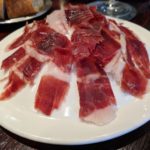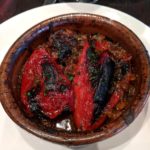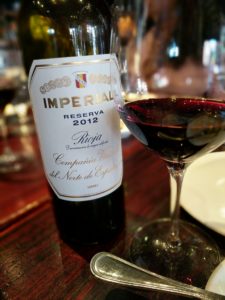 CVNE is not just any winery from northern Spain. No, really, it is the winery from northern Spain. The name CVNE, pronounced Q-nay, is actually an acronym: Compania Vinicola del Norte de Espana, which literally translates as “Wine Company from the North of Spain.”
CVNE is not just any winery from northern Spain. No, really, it is the winery from northern Spain. The name CVNE, pronounced Q-nay, is actually an acronym: Compania Vinicola del Norte de Espana, which literally translates as “Wine Company from the North of Spain.”
Admittedly it might not have been the most original moniker when the company was founded in 1879, but the nondescript name actually suits the winery just fine. As Victor Urrutia Ybarra, its current CEO, asserts, a great winery is much more than a family name or dynasty or as the work of a specific winemaker. Rather, its products continually deliver on quality unrelated to the particular people behind the bottle. That being said, CVNE’s winemakers hang around a long time; there have only been five in its 100-plus year history.
 And, while Victor is a part of CVNE’s heritage (he is a member of the fifth generation of the founding family), he took the job practically kicking and screaming all the way. Well, not really, but he was certainly a reluctant bride to the CVNE bridegroom, agreeing first to a single-year contract to see if it would work out. This was followed by a second, and then a third, single-year contract, by which time, he realized that he enjoyed the role after all. And, he has stepped into the position as if born to it (which perhaps he was).
And, while Victor is a part of CVNE’s heritage (he is a member of the fifth generation of the founding family), he took the job practically kicking and screaming all the way. Well, not really, but he was certainly a reluctant bride to the CVNE bridegroom, agreeing first to a single-year contract to see if it would work out. This was followed by a second, and then a third, single-year contract, by which time, he realized that he enjoyed the role after all. And, he has stepped into the position as if born to it (which perhaps he was).
Despite his initial reluctance, his arrival on the CVNE scene was well-timed and well-played. Bringing his expertise and training as a management consultant (he worked in Brazil for a U.S. consulting firm prior to joining CVNE), he has dramatically transformed the brand, raising its prominence both in Spain and globally over the past 15 years.
His marketing and business acumen led him to focus first on building out the export side when he took over. These efforts have been buoyed by the buying up of distribution channels and, more recently, with an expansion of the brand. This latter endeavor has been primarily centered on the purchase of abandoned vineyards and undervalued properties, especially in emerging regions. Consequently, CVNE now produces wine in Galicia, Ribera del Duero and in Catalonia, thanks to the acquisition of a Cava producer.
But, business know-how can only take you so far. It is through these changes, coupled with the company’s continued commitment to quality, that CVNE has garnered significant success. Among its many awards, was the recognition of its Imperial Gran Reserva 2004 as the #1 Wine of the Year (in 2013) by Wine Spectator magazine, the first time that a wine from Spain received this honor, further elevating the brand’s reputation and reach. The winery has also been ranked among the top 100 wineries in the world by Wine & Spirits Magazine.
Such kudos echo the company’s earliest praise, having received Gold Medals at the 1889 International Exhibition in Paris, and at the 1890 International Exhibition in Antwerp as well as taking the Grand Prix at the Paris International Exhibition in 1900. The company’s current connection to its historical roots underscore Victor’s admonition that, “What defines our future is in our past.”
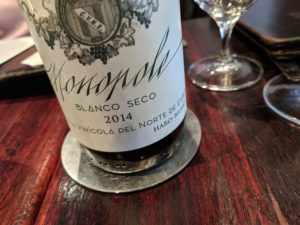 A prime example of this mantra is CVNE’s Monopole Clasico. First produced in 1915, it lays claim to being the oldest white wine brand in Spain. This unusual white was made with a small addition of Sherry to the blend, with the intent to counteract the low potential alcohol levels of the grapes at harvest and give it more backbone, which it did, along with a unique signature thanks to the Sherry’s yeastiness. Unfortunately, the wine fell out of fashion during the 1980s and CVNE stopped making altogether. However, thanks to interest from a visitor to the winery, they were inspired to reintroduce the wine, employing the original winemaker, Ezekiel, to teach them how to make it.
A prime example of this mantra is CVNE’s Monopole Clasico. First produced in 1915, it lays claim to being the oldest white wine brand in Spain. This unusual white was made with a small addition of Sherry to the blend, with the intent to counteract the low potential alcohol levels of the grapes at harvest and give it more backbone, which it did, along with a unique signature thanks to the Sherry’s yeastiness. Unfortunately, the wine fell out of fashion during the 1980s and CVNE stopped making altogether. However, thanks to interest from a visitor to the winery, they were inspired to reintroduce the wine, employing the original winemaker, Ezekiel, to teach them how to make it.
Another element of CVNE that marries its present with its past is its cellar, which has the rare distinction of having been designed by Gustav Eiffel. While previously, the winery wasn’t open to tourists, CVNE has gone all-in regarding wine tourism, welcoming 30,000 visitors annually, with time in the cellar featuring prominently in the visit. And, more recently, Victor purchased a derelict castle nearby, at which he plans to develop a more intimate tourist experience, along with a small winery, further adding to the company’s emphasis on welcoming the world at its door.
With its dedication to high quality wine production, sound and savvy business practices and a desire to grow strategically, CVNE is poised to not only sustain its current level of success, but, perhaps, to surpass it. Yet, as it extends its expansion outside of Rioja (aka the North of Spain), it might have to rethink its name ;-).
TASTING NOTES
Monopole Clasico Blanco Seco 2014, Rioja, Spain, $27.00
Given its inclusion of Sherry wine, this is not a true white Rioja, but that doesn’t make it any less delicious and, in fact, I was extremely impressed with its freshness and complexity. Dry, with bright acidity, apple and a hint of floral, culminating in long length. It also has the ability to age with time.
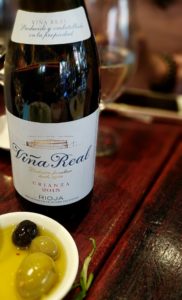 Viña Real Crianza 2015, Rioja, Spain, $17.00
Viña Real Crianza 2015, Rioja, Spain, $17.00
Hailing from a more delicate area within the Rioja region, this wine provides a juicy, fresher and younger expression of Rioja. Bright strawberry aromas and flavors with good acidity, slight oak and vanilla, long length.
Imperial Reserva 2012, Rioja, Spain, $45.00
This wine takes its name from its first bottling back in the 1920s when it was made for the English market and placed into Imperial Pint-sized vessels. Since then, Imperial has only been made in excellent vintages, with the intention of making the very best wine they can. Consequently, it is produced from a careful selection of top grapes from the company’s Rioja Alta vineyards. Notes of Spice, wood, strawberry, oak and clove, with medium acidity, medium body and very long length.
 Imperial Gran Reserva 2011, Rioja, Spain, $80.00
Imperial Gran Reserva 2011, Rioja, Spain, $80.00
As per law, the Gran Reserva spends a longer period of time aging in barrel than the Reserva wine, giving it more time to age and develop before being bottled and, ultimately, released. It also reflects the best selection of grapes. Silky smooth on the palate, this wine is still young, with red fruits, slight woodiness, elegance, finesse and a long finish. And, if that’s not enough to win you over, the 1994 vintage of this wine was served at Crown Prince (now King) Felipe’s royal wedding.
NB: If you are looking for a great place in New York City to try these (and many other Spanish wines), along with delicious tapas (such as those pictured), be sure to check out Casa Mono and its hospitable manager, Jahdea Gildin.

